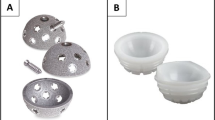Abstract
Shell deformation of resurfacing and all-metal modular cups following press-fit implantation has been reported, but not for conventional metal-backed cups with polyethylene liners. The deformation of acetabular components with historical and thin polyethylene inserts after press-fit insertion was evaluated using a cadaveric model. All shells and liners deformed upon implantation. Following joint loading, shell pinch decreased from 0.32 to 0.22 mm (p = 0.019) and from 0.29 to 0.13 mm (p = 0.003) for the thin and thick liner groups, respectively. Liner pinch also decreased from 0.17 to 0.04 mm (p = 0.031) and from 0.06 to 0 mm (p = 0.103) for the thin and thick liner groups, respectively. There were no significant differences between the thin and thick liners. Liner deformation was influenced by the initial shell deformation and donor bone quality. Shell and liner pinch decreased following joint loading, suggesting a settling in effect.




Similar content being viewed by others
References
Widmer KH, Zurfluh B, Morscher EW (2002) Load transfer and fixation mode of press-fit acetabular sockets. J Arthroplasty 17:926–935
Lin ZM, Meakins S, Morlock MM, Parsons P, Hardaker C, Flett M, Isaac G (2006) Deformation of press-fitted metallic resurfacing cups. Part 1: experimental simulation. Proc Inst Mech Eng H 220:299–309
Squire M, Griffin WL, Mason JB, Peindl RD, Odum S (2006) Acetabular component deformation with press-fit fixation. J Arthroplasty 21:72–77
Kim YS, Brown TD, Pedersen DR, Callaghan JJ (1995) Reamed surface topography and component seating in press-fit cementless acetabular fixation. J Arthroplasty 10(Suppl):S14–S21
MacKenzie JR, Callaghan JJ, Pedersen DR, Brown TD (1994) Areas of contact and extent of gaps with implantation of oversized acetabular components in total hip arthroplasty. Clin Orthop Relat Res 298:127–136
Schwartz JT Jr, Engh CA, Forte MR, Kukita Y, Grandia SK (1993) Evaluation of initial surface apposition in porous-coated acetabular components. Clin Orthop Relat Res 293:174–187
Langdown AJ, Pickard RJ, Hobbs CM, Clarke HJ, Dalton DJ, Grover ML (2007) Incomplete seating of the liner with the Trident acetabular system: a cause for concern? J Bone Joint Surg Br 89:291–295
Crowninshield RD, Maloney WJ, Wentz DH, Humphrey SM, Blanchard CR (2004) Biomechanics of large femoral heads: what they do and don’t do. Clin Orthop Relat Res 429:102–107
Bartel DL, Bicknell VL, Wright TM (1986) The effect of conformity, thickness, and material on stresses in ultra-high molecular weight components for total joint replacement. J Bone Joint Surg Am 68:1041–1051
Learmonth ID, Hussell JG, Smith EJ (1997) Inadequate polyethylene thickness and osteolysis in cementless hip arthroplasty. J Arthroplasty 12:305–309
Lee PC, Shih CH, Chen WJ, Tu YK, Tai CL (1999) Early polyethylene wear and osteolysis in cementless total hip arthroplasty: the influence of femoral head size and polyethylene thickness. J Arthroplasty 14:976–981
Dumbleton JH, D’Antonio JA, Manley MT, Capello WN, Wang A (2006) The basis for a second-generation highly cross-linked UHMWPE. Clin Orthop Relat Res 453:265–271
Ng FY, Zhu Y, Chiu KY (2007) Cementless acetabular component inserted without screws—the effect of immediate weight-bearing. Int Orthop 31:293–296
Roth A, Winzer T, Sander K, Anders JO, Venbrocks RA (2006) Press fit fixation of cementless cups: how much stability do we need indeed? Arch Orthop Trauma Surg 126:77–81
Herrera L, Lee R, Essner A, Longaray J, Wang A, Dumbleton JH, Lovell T (2007) Hip simulator evaluation of the effect of femoral head size and liner thickness on the wear of sequentially crosslinked acetabular liners. 53rd Annual Meeting of the Orthopaedic Research Society
Ong KL, Rundell S, Liepins I, Laurent R, Markel D, Kurtz S (2009) Biomechanical modeling of acetabular component polyethylene stresses, fracture risk, and wear rate during press-fit implantation. J Orthop Res 27:1467–1472
Berli BJ, Ping G, Dick W, Morscher EW (2007) Nonmodular flexible press-fit cup in primary total hip arthroplasty: 15-year followup. Clin Orthop Relat Res 461:114–121
Howard JL, Hui AJ, Bourne RB, Holdsworth DW (2005) Computed tomographic analysis of bone support for three acetabular cup designs. Clin Orthop Relat Res 434:163–169
Ong KL, Lehman J, Notz WI, Santner TJ, Bartel DL (2006) Acetabular cup geometry and bone-implant interference have more influence on initial periprosthetic joint space than joint loading and surgical cup insertion. J Biomech Eng 128:169–175
Kennedy JG, Rogers WB, Soffe KE, Sullivan RJ, Griffen DG, Sheehan LJ (1998) Effect of acetabular component orientation on recurrent dislocation, pelvic osteolysis, polyethylene wear, and component migration. J Arthroplasty 13:530–534
Acknowledgements
Research funding from Stryker Orthopaedics, Inc.
Author information
Authors and Affiliations
Corresponding author
Rights and permissions
About this article
Cite this article
Markel, D., Day, J., Siskey, R. et al. Deformation of metal-backed acetabular components and the impact of liner thickness in a cadaveric model. International Orthopaedics (SICOT) 35, 1131–1137 (2011). https://doi.org/10.1007/s00264-010-1077-6
Received:
Revised:
Accepted:
Published:
Issue Date:
DOI: https://doi.org/10.1007/s00264-010-1077-6




